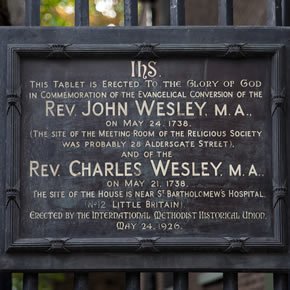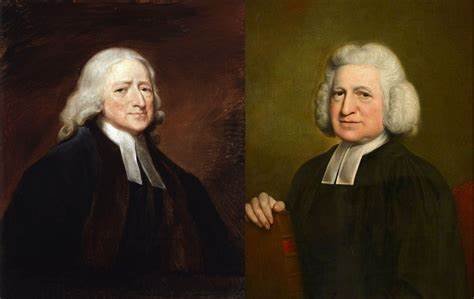Five hymns for Aldersgate
Explore the events and meaning of the Wesley brothers’ conversion experiences through hymns featured on Singing the Faith Plus.

Aldersgate Sunday falls each year on the Sunday immediately preceding 24 May (‘Wesley Day’), the day on which Methodists mark John Wesley’s life-changing experience at a meeting in Aldersgate Street, London. (See plaque, right)
Before May 1738, no-one would have said that John and Charles Wesley were anything but devout Christian men. So what changed for them so much that Charles would write of his “conversion”:
Where shall my wondering soul begin
How shall I all to heaven aspire?
A slave redeemed from death and sin,
A brand plucked from eternal fire...
Aldersgate – five hymns that tell the story
Two of Charles’ most powerful hymns were written in the immediate aftermath of his own "conversion". Both begin with questions born out of wonder, and express assurance of God’s love that provided the bedrock for the brothers' future ministry.
1. Where shall my wondering soul begin? (StF 454)
Charles began writing this hymn two days after his conversion experience on 21 May 1738. He and John are said to have sung it following John’s own experience in Aldersgate Street on the 24th. (There is a short account of the ‘conversions’ of Charles and John Wesley here.)
2. And can it be that I should gain an interest in the Saviour's blood? (StF 345)
Wesley contrasts light and darkness, life and death, slavery and freedom, and Christ's righteousness and our unrighteousness, in order to express the mystery of God's grace extended to sinners who turn to Christ in faith. Like “Where shall my wondering soul begin?”, Charles wrote this hymn shortly following his own conversion. Its many scriptural references reflect his intimate knowledge of the Bible (e.g. Philippians 2: 7, Acts 12: 6-8, Romans 8: 1, and Hebrews 4: 16)
3. A third hymn that reflects the essence of the "Aldersgate experience" is Martin Luther's Out of the depths I cry to thee (StF 433)
Luther’s paraphrase of Psalm 130 carries the same emphasis on the saving grace of God that is found in his Preface to the Epistle to the Romans, which John Wesley (left – statue at Wesley Chapel, London) listened to being read on the night of his conversion experience.
Two contemporary hymns about the Wesleys' ministry:
4. How small a spark has lit a living fire! (StF 408)
Written for the Wesley 250th Anniversary in 1988 by New Zealander Shirley Erena Murray, this hymn captures some of the best known features of John Wesley’s post-conversion ministry.
5. Best of all is God is with us (StF 610)
With a first line that quotes John Wesley’s final recorded words, Andrew Pratt goes on to celebrate John Wesley’s life. He alludes to Wesley's conversion (“hearts are challenged, strangely warmed”) and to the assurance of God’s presence in everything, which spurred Wesley on to a new kind of ministry.
Singing with the Wesleys
Singing the Faith includes 82 hymns by the Wesley brothers, Charles and John (79 of them by Charles). Consider exploring one or more of these in depth as you mark Wesley Day and Aldersgate Sunday.
On Singing the Faith Plus, nine Wesley hymn posts also include information and ideas for use. As well as explanations and backgrounds of the hymn texts, suggestions for how they may be used range from related readings (StF 436) and story ideas (StF 454) to discussion questions for small groups (StF 620).
- All you that seek the Lord who died (StF 294)
- Come, and let us sweetly join (StF 646)
- Come, O thou Traveller unknown (StF 461)
- Let earth and heaven combine (StF 208)
- O for a thousand tongues to sing (StF 364)
- Open, Lord, my inward ear (StF 450)
- Thou God of truth and love (StF 620)
- What shall I do my God to love (StF 436)
- Where shall my wondering soul begin? (StF 454)
The Wesley story

For introductory materials on John and Charles Wesley, and the movement they founded, go to the Methodist History section of the new Methodist Heritage website.